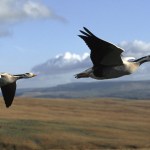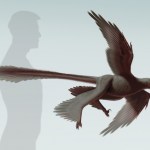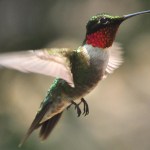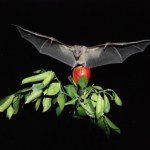flight
Image of a variety of bird eggs from Internet Archive Book Images, via Wikimedia Commons
Ever wonder why bird eggs are shaped the way they are and what drives the variations in egg shapes across species? I never really wondered that either until I saw an article in Science that explained a possible reason...then I just HAD to know. Some theories had been proposed suggesting that their shape prevented eggs from rolling out of nests or otherwise sustaining damage, and so on. According to the new study, the shape of a bird's eggs may be related to their ability to fly…
Image of ruby-throated hummingbird by Joe Schneid, Louisville, Kentucky (Own work) [CC BY 3.0 (http://creativecommons.org/licenses/by/3.0)], via Wikimedia Commons
In a new study published in The Auk, scientists report that well-fueled older tiny Ruby-throated Hummingbirds (Archilochus colubris) might be capable of non-stop flights of over 4,000 kilometers, wind conditions permitting. They made this remarkable observation while studying birds from 2010-2014 as the animals made stopovers at a wildlife refuge during their annual migration to South…
Dr. Vivek Jayaraman and colleagues at the Howard Hughes Medical Institute Janelia Research Campus discovered that the ellipsoid body located in the middle of a fly's brain acts like a compass to help navigate flight even in darkness. By placing the flies into a small virtual reality arena and having the flies walk on a rotating ball, they could study the activity of neurons within the ellipsoid body while the animal was moving.
These videos show how the fly experiment was done:
Check out the news release for more information about this neat study.
Image of bar headed geese in flight from John Downer/Nature Picture Library/Corbis
I listened to a really interesting story on NPR this morning about new discoveries regarding the flight patterns of bar-headed geese. These birds are known for their incredible ability to fly over the Himalayas on their annual migration to central Asia. Until now, it was often assumed that the birds reached a specific altitude and then simply maintained it for the duration of their migratory route. A new study published on Thursday in Science questioned this assumption.
Dr. Doug Altshuler (…
New research from Vanderbilt University shows that hummingbirds and insects have a lot in common...when it comes to flying at least. The researchers placed nontoxic paint on the wing of a ruby-throated hummingbird at 9 different spots then videotaped the animal flying at 1,000 frames per second with 4 cameras simultaneously. Using 3D simulations of the hummingbird flight, they discovered that the tiny birds stir up air around their wings in a way similar to insects like mosquitoes and dragonflies.
Larger birds obtain much of their energy for flight from the downstroke of the wing as it pushes…
This newly discovered feathered dinosaur, Changyuraptor yangi, was built like a modern airplane. Illustration by S. ABRAMOWICZ, DINOSAUR INSTITUTE, NHM.
Photo of fossil by: Luis Chiappe Dinosaur Institute, NHM as published in the USA Today
The discovery of this non-avian dinosaur, Changyuraptor yangi, that lived 125 million years ago suggests that flight came before birds. The fossil was discovered in the Liaoning Province of northeastern China by Luis Chiappe from the Natural History Museum in Los Angeles, CA. At nearly 4 feet long, it is the largest so-…
Brandy Velten (doctoral student) and Dr. Kenneth Welch (Comparative Physiologist) from the University of Toronto wanted to know whether birds with very different speeds at which they flaps their wings (i.e. wingbeat frequencies) had correspondingly varying types of myosin proteins in their muscles. Their findings were published in the American Journal of Physiology last month.
In their study they compared ruby-throated hummingbirds and zebra finches which reportedly have some of the highest wingbeat frequencies (20-60Hz). As you can imagine, their flight muscles are made up of almost…
Amazon Prime Air might want to pay attention to this research. Scientists have studied the flight patterns of albatrosses to understand how the animals are able to sustain flight with minimal energy expenditure.
New research provides more evidence of how birds conserve energy by flying in a "V" formation:
In honor of our most beloved Thanksgiving dinner guest:
Despite their rather large stature, ranging from 2.5-10.8 kg, wild turkeys (Meleagris gallopavo) can fly as seen in this video:
For more information about turkeys:
Cornell Lab of Ornithology
Clip Art from www.LeeHanson.com
Just in time for Halloween:
Besides being an excellent way to avoid predators, roosting or hanging upside down is optimal for taking off into flight. Bats are not able to launch into flight from an upright position because their wings do not generate sufficient lift while at a dead stop. Additionally, their hindlegs are rather underdeveloped, so they are not able to run to generate lift for take-off. Instead, bats essentially fall into flight.
Learn more in this video comparing flight mechanics in bats and birds:
Source:
Animal Plant
When we navigate through our environment, do we track mostly in two dimensions or in three? Clearly, we can move in all three dimensions, but does our internal map relate to the vertical direction in the same way as it does to the horizontal axes on the ground?
That question has not yet been definitively answered, but recent research on flying bats shows us what three-dimensional navigation looks like in the brain.
It turns out that fruit bats also mostly navigate in two dimensions, since quite a bit of their flying time involves getting from their caves straight to their favorite fruit…
tags: The Science Behind Gliding Paper Airplanes, physics, teaching, flight, pressure, paper airplanes, streaming video
Do you need a fun, hands-on experiment for your physics classroom? This video shows how a group of high school students, led by a terrific teacher, made origami paper airplanes from phone book pages that glide on a wave of air and what they learned from this experience. Magnificent.
tags: evolution, evolutionary biology, UV light, flight, dinosaur, dromaeosaur, theropods, Microraptor gui, paleontology, fossils, birds, researchblogging.org,peer-reviewed research, peer-reviewed paper, journal club
Figure 1. The holotype of Microraptor gui, IVPP V 13352 under normal light. This shows the preserved feathers (white arrow) and the 'halo' around the specimen where they appear to be absent (black arrows). Scale bar at 5 cm. [larger view]
DOI: 10.1371/journal.pone.0009223
It has long been known that when exposed to ultraviolent light, fossilized bones and shells -- and even…
We shall not cease from exploration and the end of all our exploring will be to arrive where we started... and know the place for the first time. -T.S. Eliot
Yesterday, President Obama delivered his first State of the Union Address, and talked about a number of things that ranged from inspiring to disappointing. But one thing that didn't make it into the address was the rumor that NASA's Constellation program (including the Ares Rocket designed to launch crews) will lose their government funding.
(Please note: what follows is my opinion, and I take responsibility for it.) If this actually…
One of the coolest dinosaurs you learn about as a kid are Pterodactyls (really Pterosaurs, but who's checking). As giant flying lizards, these guys are thought to have dominated the skies long before birds existed (from the late Triassic to the end of the Cretaceous, 220-65 million years ago). The biggest of the bunch are Pteranodon and Quetzalcoatlus, which are thought to have weighed as much as 250 kg with wingspans in excess of 30 feet.
But a new study, published in PLoS ONE is casting doubt on the ability of these massive winged dinos to actually fly. Instead, their results add to others…
In the summer of 2007, thirty-four travellers left home with backpacks in tow to see the world. But these weren't human students, out to get drunk and pretentious find themselves in foreign lands - they were small songbirds, migrating to tropical climates for the winter.
Their backpacks were light-measuring devices called "geolocators", each about the size of a small coin. By measuring rising and falling light levels, these miniature contraptions revealed the timings of sunrise and sunset wherever the birds happened to be flying. Those, in turn, revealed where they were in the world, and…
I sometimes wonder if a major reason why most people don't really get insects is the difference in pace between how we and how the insects move in the world.
Insects live faster than we do, their everyday motions an erratic, unintelligible blur to our sluggish perceptions. But slow them down so that we can see them on their own terms, and they seem almost as different creatures, more deliberate, more wise, and certainly much less buggy.
Coccinella septempunctata
This weekend's project: to shoot a beetle in flight. I chose ladybirds not because they are pretty, but because they are the slowiest, clumsiest beetles I could find in any number.  An easy target.
I had a cast of several beetles from two species, the seven-spotted ladybird Coccinella septempunctata and the multi-colored ladybird Harmonia axyridis. I placed the beetles inside a whitebox with a backdrop of leaves, along with my Canon 550 speedlite flash, and tried to capture the beetles as they launched themselves into the air. The…
tags: ratite, tinamous, evolution, biogeography, phylogenomics, convergence, flightlessness, Paleognath, homoplasy, vicariance
White-throated Tinamou, Tinamus guttatus.
Image: Wikipedia.
New research suggests the ostriches, emus, rheas and other flightless birds known as ratites have lost the ability to fly many times, rather than just once, as long thought. Further, the ratites appear to form a group with the tinamous, a group of birds that can fly, while the ostriches are set apart as the "sister group" -- the closest relatives.
Birds are divided into two groups based on jawbone…





